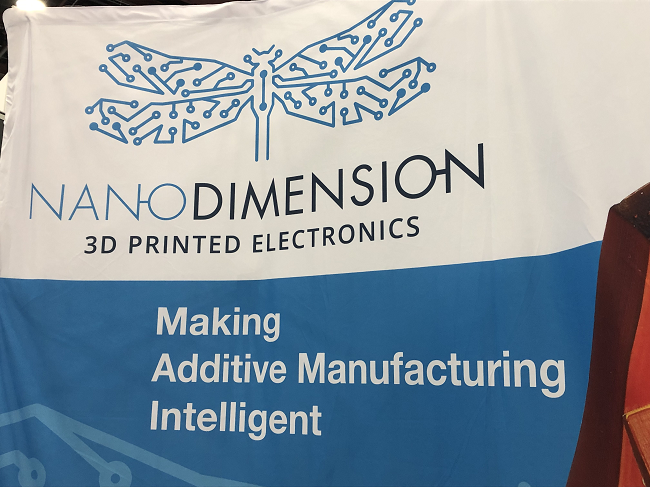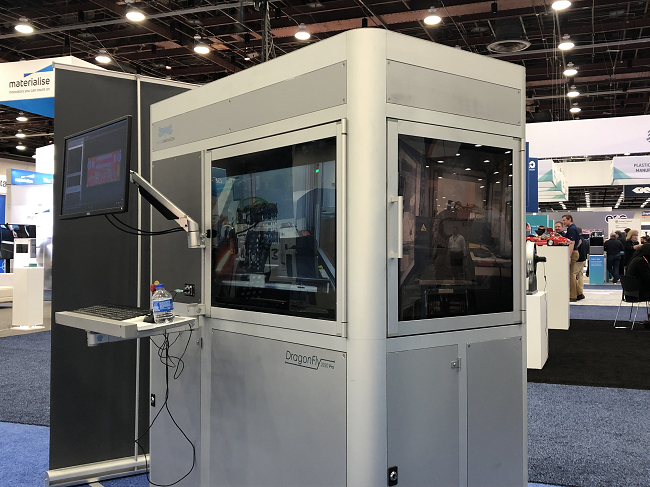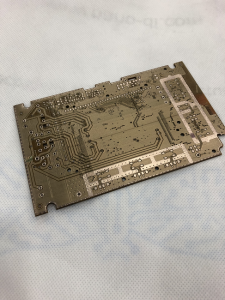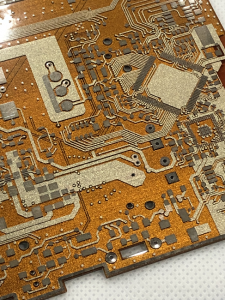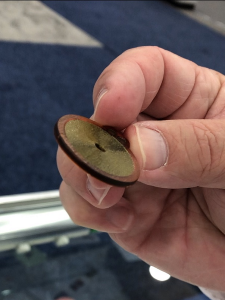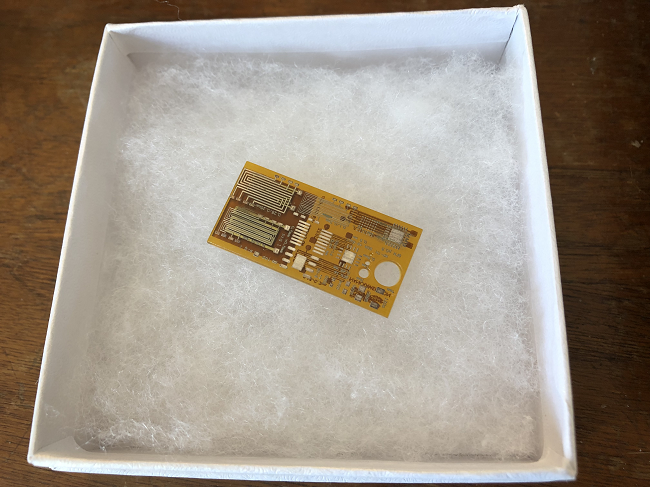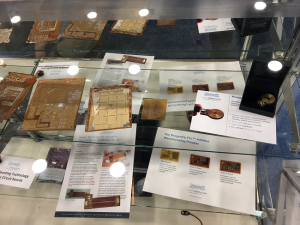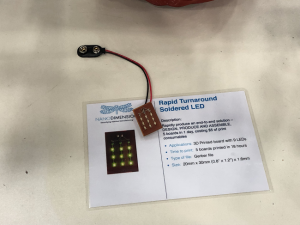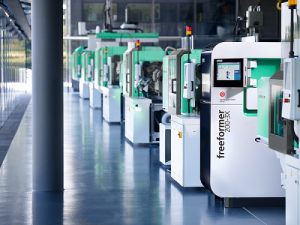Nano Dimension Continues its Growth in the 3D Printing Industry
Israeli PCB print leader Nano Dimension showed off its DragonFly 2020 Pro 3D printer at a US event for the first time while attending RAPID + TCT in Texas last year. Not too long ago, I finally had the opportunity to see the machine for myself while attending this year’s RAPID in Detroit, Michigan.
The industrial PCB printer was the first thing I saw at the booth – it’s hard to miss, being much taller than its desktop predecessor. The system stands on the floor and offers a larger footprint, though it has the same 20 x 20 cm print area as the original DragonFly 2020, which officially ended its beta program in the summer of 2017. Tim Sheehan, the VP of Global Sales and Customer Care for Nano Dimension USA Inc., came over to greet me, and we sat down to chat.
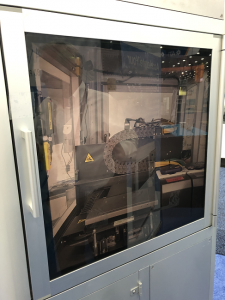 Sheehan used the example of an electrical engineer looking to make a prototype board, noting that everything involved in the process – from finding a business to make the prototype, filling out and getting a purchase order approved, having the prototype made and getting it shipped to you – can cost thousands of dollars and take months to complete.
Sheehan used the example of an electrical engineer looking to make a prototype board, noting that everything involved in the process – from finding a business to make the prototype, filling out and getting a purchase order approved, having the prototype made and getting it shipped to you – can cost thousands of dollars and take months to complete.
“That’s the standard process that people deal with today,” he said.
“Now, along comes someone who says, what if I could increase your productivity and reduce your cycle time…that’s giving you a return on investment that’s going to help.”
Then we walked over to the DragonFly 2020 Pro so I could get a closer look. Sheehan explained that a dielectric ink (DI) and a conductive ink are both cured at almost the same time within the system.
“It takes sophisticated software to calculate the algorithm to make sure that what you want to be a feature on that board…something as simple as a hole…it places the hole each time at the appropriate place.
“The board is being printed on a chuck, and that chuck is a heating element and a holding element, so it’s holding what’s being printed.”
The chuck moves back and forth, while the ink is being distributed exactly where it’s supposed to go. Nano Dimension uses a free SOLIDWORKS add-in which, according to its website, “creates a design environment optimized for 3D printing multi-material electronics.”
“So all of this can allow that electrical engineer not to take all that time – that two days for approval, a week to get all the signatures, three to five weeks for the board to show back up, ordering of components – all that time. You can now have a board printed overnight.”
Sheehan told me that, as an engineer, the first design you come up with is never the best. The DragonFly 2020 Pro really helps to speed up the design process, so if you need to make changes and iterations, you’re not wasting everyone’s time. He then showed me some examples of what the PCB printer is capable of, including a 12-layer PCB (below) that took a total of 20 hours to print.
“Time is only determined by the amount of silver we want to put down,” he explained.
“No one else in here can do this. The only way this is being done is the old-fashioned, traditional way, which is one layer at a time is created.”
He also showed me a PCB with an indentation on one end where a battery will sit, which also features a circuit that’s on multiple layers.
Next, Sheehan brought out a sample that demonstrates a helical conductive coil – created in 180 extremely fine turns – that’s embedded in the company’s dielectric ink; this shows Nano Dimension’s ability to create non-planar conductors, and embed them in a structure, in a single process. This can be used in applications such as charging cell phones or as a solenoid, which acts like a magnet when carrying electric current.
“Solenoids generally grab something locked…unlock the solenoid, door opens,” he explained.
“I have children, I’m not home, they come home from school, the door opens, the signal gets sent, I know they’re home. This is the whole IoT, right? Related to electronics.
“So how this all plays through for us is I’m helping you increase productivity.”
I asked Sheehan if anything new was happening with Nano Dimension that he could tell me about, and he said that the company had recently begun a European expansion, in addition to completing its partner development in North America.
“We’ve signed on national and global leaders in additive manufacturing.”
He listed some of these, including additive solutions and SOLIDWORKS software reseller Go Engineer, CATI, and Fisher Unitech, which is the largest Stratasys reseller in the world.
“So, what else is new for us? A lot of what we call application development sharing – we’re introducing how we can help people side mount components, how we can help people create three-dimensional applications, like the inductive coil,” Sheehan explained. “That’s just a few of the many different, what we call ‘feature applications,’ we’re introducing to help people stretch their minds around what else you can do with the DragonFly.”
Nano Dimension has been listening to its customers, and until this point, the company’s “addressable market” has been R&D with major research institutes. But now, the US Department of Defense is one of the top markets it’s addressing, after becoming a certified DoD vendor last June.
“They are the biggest single organization buying from us today,” Sheehan said, noting that Tier 1 suppliers are also purchasing DragonFly printers. “There are different Army, Navy, Air Force branches buying this system, doing things that we don’t even really know because it’s not for us to know…we’re probably not allowed to know.
“So that’s exciting because when you bring a product to market, you want to know who to address in the market, you want to make sure you go target that. But what’s important is we gather the information from them, and then come back and do the appropriate things for the future of the product. So that’s been successful for us.”
Before I left, Sheehan presented me with my very own 3D PCB, which now sits on my desk next to a myriad of other prints I’ve made or been given. I was excited to receive the PCB, not only because it’s a good physical reminder of what 3D printing is capable of, but also, as I said to Sheehan, who doesn’t like to be handed a little white box?
Stay tuned for more on 3DPrint.com’s trip to RAPID + TCT 2019, and take a look at more pictures from the Nano Dimension booth below:
Discuss this story and other 3D printing topics at 3DPrintBoard.com or share your thoughts below.
[Images: Sarah Saunders]
America Makes ready for “Game Day” at RAPID 2019
Sigma Labs PrintRite3D technology validated by DARPA study
3D Printing News Briefs: February 6, 2018
We’re talking about business, training, and events on today’s 3D Printing News Briefs. The first European 3D printing incubator will soon be inaugurated in Barcelona, and 3devo is launching training workshops about desktop filament extrusion. nScrypt’s Director of 3D Printing and a surgeon from Belfast will be presenting at upcoming events, and Arburg will display a complete turnkey system at an Italian trade fair. Finally, because we celebrate all accomplishments in our industry, we’re sharing some good news about a Xometry employee.
3D Factory Incubator Inauguration
 This coming Monday, February 11th, the inauguration of the first European incubator of 3D printing – 3D Factory Incubator – will take place in Barcelona. The Minister of Science, Innovation and Universities, Pedro Duque, will chair the inauguration’s opening act. This High-Tech Business Incubator, a project led by Fundación LEITAT and El Consorci de Zona Franca de Barcelona (CZFB), is working to promote the adoption of 3D printing by creating a space to incubate related SMEs and micro-SMEs.
This coming Monday, February 11th, the inauguration of the first European incubator of 3D printing – 3D Factory Incubator – will take place in Barcelona. The Minister of Science, Innovation and Universities, Pedro Duque, will chair the inauguration’s opening act. This High-Tech Business Incubator, a project led by Fundación LEITAT and El Consorci de Zona Franca de Barcelona (CZFB), is working to promote the adoption of 3D printing by creating a space to incubate related SMEs and micro-SMEs.
The 600 sqm incubator space is located at CZFB’s headquarters, and will include training areas, offices, meeting rooms, laboratories, and co-working zones, in addition to a variety of services. The inauguration will begin promptly at 11 am.
3devo Launching Training Workshops
 Dutch technology company 3devo, which creates desktop-based material development and recycling solutions such as SHR3D IT, is launching a series of hands-on training workshops all about desktop filament extrusion for professionals, which will be branded as DevoTraining. The workshops will be held at 3devo’s Utrecht headquarters, and participants can choose one of three programs: a basic, 4-hour module for €499, a 1-day intermediate workshop for €899, and a 2-day advanced level course for €1549.
Dutch technology company 3devo, which creates desktop-based material development and recycling solutions such as SHR3D IT, is launching a series of hands-on training workshops all about desktop filament extrusion for professionals, which will be branded as DevoTraining. The workshops will be held at 3devo’s Utrecht headquarters, and participants can choose one of three programs: a basic, 4-hour module for €499, a 1-day intermediate workshop for €899, and a 2-day advanced level course for €1549.
“The demand for unique 3d printing materials is ever-growing, which requires new knowledge on how to process it,” said Tim Wesselink, the CEO of 3devo. “With DevoTraining, we offer the answers to those innovators who seek to take matters into their own hands. Giving them complete guidance to create and customize their own filament – on demand.”
DevoTraining will be officially released next Tuesday, February 12th.
nScrypt Discussing 3D Printed Munitions and Other DoD Applications
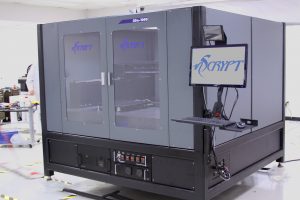 Orlando, Florida-based nScrypt, which manufactures micro-dispensing and 3D printing systems, announced the release of its hybrid Factory in a Tool (FiT) integrated system for Direct Digital Manufacturing in October. nScrypt’s Director of 3D Printing, Larry (LJ) R. Holmes, Jr., is in charge of directing the company’s market participation for industrial-level 3D printing hardware, including its work with the US Department of Defense (DoD). This week, Holmes will speak about nScrypt’s 3D printed munitions, as well as its other DoD applications, on the “AM Innovation Panel: Developing the Next Generation of 3D Printing and Processes in Support of the Warfighter” in Tampa at the Military Additive Manufacturing Summit & Technology Showcase.
Orlando, Florida-based nScrypt, which manufactures micro-dispensing and 3D printing systems, announced the release of its hybrid Factory in a Tool (FiT) integrated system for Direct Digital Manufacturing in October. nScrypt’s Director of 3D Printing, Larry (LJ) R. Holmes, Jr., is in charge of directing the company’s market participation for industrial-level 3D printing hardware, including its work with the US Department of Defense (DoD). This week, Holmes will speak about nScrypt’s 3D printed munitions, as well as its other DoD applications, on the “AM Innovation Panel: Developing the Next Generation of 3D Printing and Processes in Support of the Warfighter” in Tampa at the Military Additive Manufacturing Summit & Technology Showcase.
“Our FiT platform is ideal for DoD’s 3D printing applications because it does next generation Direct Digital Manufacturing, which means no retooling to build a product or to change from printing one product to another. Just change the CAD file. Our FiT’s pick and place tool head adds actives to the prints, making them electrically functional if needed. We just delivered a Factory in a Tool to the Army’s Redstone Arsenal. It has one full meter of travel in the XY plane,” Holmes said.
“nScrypt’s goal is to disrupt how manufacturing happens. Munitions printed on-demand, where and when they are needed; a ruggedized 3D printer for use in forward deployed locations; and printed electronics, like conformal Active Phased Array Antennas for improved performance at lower cost, are a few of the examples of capabilities currently being transitioned from nScrypt to the DoD and the global manufacturing industrial base.”
SXSW 3D Printing Presentation About 3D Printed Kidney Model
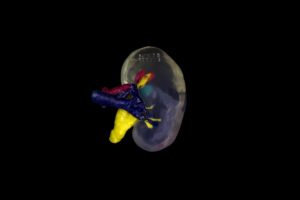 SXSW 2019 begins next month in Texas, and in addition to the many other innovations on display at the event, Dr. Tim Brown, Consultant Transplant Surgeon at Belfast City Hospital, will share his experience of using 3D printing to successfully perform a first of its kind, life-saving operation during a presentation titled “Tumours, Transplants and Technology: AI for Life.” His patient needed a life-saving kidney donation, and while her father was willing to donate, his kidney had a tumor on it. Together with UK medical 3D printing company axial3D and Digital Catapult, Dr. Brown used a 3D printed kidney model to safely complete the transplant surgery and save his patient’s life.
SXSW 2019 begins next month in Texas, and in addition to the many other innovations on display at the event, Dr. Tim Brown, Consultant Transplant Surgeon at Belfast City Hospital, will share his experience of using 3D printing to successfully perform a first of its kind, life-saving operation during a presentation titled “Tumours, Transplants and Technology: AI for Life.” His patient needed a life-saving kidney donation, and while her father was willing to donate, his kidney had a tumor on it. Together with UK medical 3D printing company axial3D and Digital Catapult, Dr. Brown used a 3D printed kidney model to safely complete the transplant surgery and save his patient’s life.
“As the cyst was buried deep within the renal cortex and therefore invisible on the back bench, a replica 3D model was used for preoperative planning and intra-operative localization of the lesion,” explained Dr. Brown. “It’s difficult to underestimate how valuable this strategy was in terms of preoperative planning and achieving successful clearance of the lesion.”
axial3D won the Healthcare Application Award at the 2018 TCT Awards for creating the 3D printed model, and the company’s CEO Daniel Crawford and Operations Manager Cathy Coomber will join Dr. Brown for a panel discussion at SXSW, along with Nigel McAlpine, Immersive Technology Lead at Digital Catapult. The session will take place at SXSW on March 12th, at the JW Marriott Salon FG.
Arburg Exhibiting at MECSPE 2019
At next month’s MECSPE 2019 trade fair in Italy, German machine construction company Arburg will be focusing on 3D printing, automation, and digitalization. The company will be displaying a complex turnkey system, built around a Freeformer 200-3X industrial AM system and a hydraulic Allrounder 370 S; both the Freeformer and Allrounder are networked live with the company’s ALS host computer system. In addition to displaying the system at the trade fair, Arburg will also have experts presenting their outlook on the digital future of plastics processing at Stand F49 in Hall 6.
“MECSPE 2019 is the most important trade fair for the manufacturing industry in Italy and, with its focus on Industry 4.0 and automation, it is an ideal match for Arburg. We are not only a machine manufacturer and expert in injection moulding, but we also have our own MES, our own controllers, automation technology and the Freeformer for industrial additive manufacturing as part of our product portfolio,” said Raffaele Abbruzzetti, the new Managing Director of Arburg Srl. “With more than 30 years of experience in networked and flexibly automated production, we offer our customers everything they need in the era of digitalisation to increase their added value, production efficiency and process reliability – from the smart machine to the smart factory and smart services. We will present examples of all of this at MECSPE.”
Xometry Employee Wins Game Show
 This last News Brief has nothing to do with 3D printing itself, but rather an unrelated, but still incredible, accomplishment from one of the industry’s own. On Thursday, January 24th, employees from on-demand manufacturing and 3D printing service provider Xometry gathered to watch one of their colleagues – marketer Aaron Lichtig – compete, and eventually win big, on the popular Jeopardy! game show that night.
This last News Brief has nothing to do with 3D printing itself, but rather an unrelated, but still incredible, accomplishment from one of the industry’s own. On Thursday, January 24th, employees from on-demand manufacturing and 3D printing service provider Xometry gathered to watch one of their colleagues – marketer Aaron Lichtig – compete, and eventually win big, on the popular Jeopardy! game show that night.
Lichtig started off at a steady pace, competing against returning champion and astrophysicist Rachel Paterno-Mahler and sales manager Nancy Rohlen, and was leading the pack with a final score of $12,400 by the end of the Double Jeopardy round. He squared off against Rohlen during Final Jeopardy with the clue, “He was the first U.K. prime minister born after Elizabeth II became queen.” While both correctly guessed the answer as Tony Blair, Lichtig’s steep lead made him the winner that night. Congratulations from your friends at 3DPrint.com!
Discuss this news and other 3D printing topics at 3DPrintBoard.com or share your thoughts below.
Contour Crafting Will Develop Concrete 3D Printer for Disaster Relief, Thanks to DoD Contract
One of the very first methods of large-scale 3D printing that the world witnessed was the technology of Contour Crafting Corporation, which uses large but lightweight robotic 3D printers to quickly put down layers of building material in order to rapidly create entire buildings onsite in just days.
Last week, we learned that the US Department of Defense (DoD) had recently awarded California-based Contour Crafting a $3 million research and development contract, effective July 25th, 2018, in the large-scale, construction 3D printing domain. Contour Crafting will use this Rapid Innovation Fund (RIF) to build a concrete 3D printer for the purposes of Rapid Response Construction – quickly constructing buildings for disaster relief, an application that often makes use of 3D printing.
According to the company’s website, “The outcome of this funded R&D program is expected to be a technology which, among other applications, will effectively respond to disaster relief situations with expedient, safe and sustainable structures and buildings.”
The RIF was awarded to Contour Crafting based on its proposal, titled “Autonomous Construction Equipment and Sensing (ACES).” I assume this ACES is not to be mistaken for the US Army’s other ACES program, but as the location on the Federal Business Opportunities page is listed as CERL in Champaign, Illinois, one can’t be too sure.
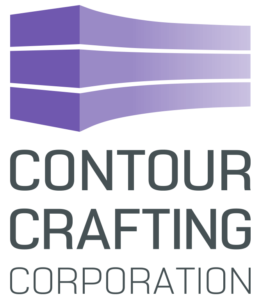 Regardless, this contract award to Contour Crafting confirms that the DoD is interested in seeking outside help for its construction 3D printing goals, as opposed to just keeping things in-house…never a bad idea.
Regardless, this contract award to Contour Crafting confirms that the DoD is interested in seeking outside help for its construction 3D printing goals, as opposed to just keeping things in-house…never a bad idea.
Speaking of construction 3D printing goals, Contour Crafting is on a mission to commercialize disruptive construction technologies, and this funding award from the DoD should definitely help the company on its way to achieving it.
In 2015, Dr. Behrokh Khoshnevis, who developed the company’s Contour Crafting technology at the University of Southern California and is its CEO and founder, predicted during an interview with 3DPrint.com that 3D printed homes would be widespread within five years. While the 3D printed housing sector is certainly hard at work, we are definitely not there yet. However, 3D printed construction technology does seem to be the perfect answer for smaller structures, like an army barracks and emergency housing, so it’s smart to focus on these while continuing to build up the technology until it’s ready.
While I did not learn too much more about the company’s newly awarded DoD contract, perhaps due to a non-disclosure agreement or something similar, Dr. Khoshnevis was kind enough to answer some questions for me in regards to Contour Crafting’s construction 3D printing technology, as well as the company’s plans for the future.
How does Contour Crafting’s technology compare to other construction 3D printing?
“CC Corp is currently pursuing both construction and non-construction application domains. The latter has the main advantage of not being subject to regulatory restrictions and the complex and potentially costly process of obtaining approval of regulatory authorities for conformance to building codes, which incidentally is different for different localities because of varying factors such as extent of seismic activities and climatic conditions.
“In the field of construction we are advancing more cautiously as we are exploring potential implementation problems and solutions. We are doing many experimentations in-house and are preparing for some field tests as well.
“We have maintained our interest in the field of planetary construction as our prior accomplishments in the field, which include two NASA international competition Grand Prizes, have been noteworthy. We are developing new technologies for in-situ material usage for construction of a variety of useful infrastructure elements such as landing pads, blast protection walls, shade walls, radiation shielding walls, hangars, and roads.”
Discuss this story and other 3D printing topics at 3DPrintBoard.com or share your thoughts in the Facebook comments below.
3D Printing News Briefs: August 10, 2018
We’ve got some business news to start things off with in today’s 3D Printing News Briefs, followed by a little research and a really cool 3D printed costume. The Department of Defense has awarded a contract to Contour Crafting, and Sutrue is celebrating its tenth anniversary. Facebook has made the decision to ban blueprints for 3D printed guns, and a Siggraph paper takes an in-depth look into near-eye displays. Finally, several companies helped the non-profit organization Magic Wheelchair make a really cool 3D printed wheelchair costume for a big Star Wars fan.
Contour Crafting Receives Department of Defense Contract
 One of the first methods of large-scale 3D printing, Contour Crafting, uses large but lightweight robotic 3D printers, which can quickly put down layers of building material to rapidly create entire buildings onsite in just days. The California-based corporation itself is on a mission to commercialize disruptive construction technologies, and we recently learned that the US Department of Defense (DoD) has awarded Contour Crafting a $3 million research and development contract to build a concrete 3D printer for the purposes of building construction for disaster relief.
One of the first methods of large-scale 3D printing, Contour Crafting, uses large but lightweight robotic 3D printers, which can quickly put down layers of building material to rapidly create entire buildings onsite in just days. The California-based corporation itself is on a mission to commercialize disruptive construction technologies, and we recently learned that the US Department of Defense (DoD) has awarded Contour Crafting a $3 million research and development contract to build a concrete 3D printer for the purposes of building construction for disaster relief.
According to the company’s website , “Effective 25 JUL 2018, the Department of Defense has awarded Contour Crafting Corporation with a Rapid Innovation Fund contract in the domain of large and construction scale 3D printing. The outcome of this funded R&D program is expected to be a technology which, among other applications, will effectively respond to disaster relief situations with expedient, safe and sustainable structures and buildings.”
This information confirms that the DoD is not putting all of its eggs into one basket, so to speak, and is seeking outside help for its construction 3D printing goals.
Sutrue Celebrates Ten Years
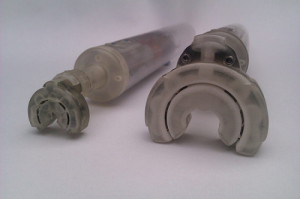 Medical device startup Sutrue first started working on a 3D printed suture stitching device to help prevent needle stick injuries back in 2014, and became the first company to successfully 3D print a suture device. But Sutrue’s story actually began back in August of 2008, when its founder Alex Berry was stuck at home with a broken ankle and watched a documentary that provided some insight into robotic suturing. In an effort to keep busy during his recovery, Berry, who had some basic CAD knowledge, got to work.
Medical device startup Sutrue first started working on a 3D printed suture stitching device to help prevent needle stick injuries back in 2014, and became the first company to successfully 3D print a suture device. But Sutrue’s story actually began back in August of 2008, when its founder Alex Berry was stuck at home with a broken ankle and watched a documentary that provided some insight into robotic suturing. In an effort to keep busy during his recovery, Berry, who had some basic CAD knowledge, got to work.
After moving to the UK, Berry officially started Sutrue in 2012, meeting some influential people along the way who helped him get closer to achieving his goal of creating a 3D printed suture device. The startup completed a £30,000 crowdfunding campaign in 2014, submitted another patent, developed a few mutually beneficial relationships with other companies, and secured further funding for continued device development. Now, Sutrue is celebrating the 10th anniversary of Berry’s initial idea.
The startup wrote in a post, “It’s been ten years of ups and downs, filled with much uncertainty particularly in the first five years in which Berry didn’t even know for sure that the device would work. He has maintained the progression of the device through having a healthy dose of insanity, extreme resourcefulness, and an inquiring and problem-solving mind. He’s gone against many societal norms to have created two working prototypes of his automated suturing device – the robotic and the handheld, but as the route to market becomes closer and closer, he’s glad to have fought against the odds to see the project through to completion.”
Facebook Bans 3D Printed Gun Blueprints
There’s been an increased amount of conversation on the topic of 3D printed guns recently, after news broke of a settlement between the US State Department and Texas open source 3D printed gun designer Defense Distributed, run by Cody Wilson. The settlement states that Wilson and his non-profit organization can publish files, plans, and 3D drawings of guns in any form, and are also exempted from export restrictions; additionally, the government will be paying nearly $40,000 of Wilson’s legal fees. This means that people who weren’t legally able to purchase firearms before, such as felons and domestic abusers, can 3D print their own guns without serial numbers. As you can imagine, many are not happy with this decision. This week, Facebook, the world’s largest social network, said that it will ban any websites that host and share blueprints of 3D printed guns, though the designs have already been available online for years.
According to BuzzFeed News, a Facebook spokesperson said, “Sharing instructions on how to print firearms using 3D printers is not allowed under our Community Standards. In line with our policies, we are removing this content from Facebook.”
MSN reports that Facebook did not “immediately respond to a request for comment regarding the Ghost Gunner” 3D printed gun.
Siggraph Paper on Optical Design for Augmented Reality Near Eye Displays
 This year’s annual conference on computer graphics, SIGGRAPH 2018, starts this Sunday, August 12th, in Vancouver. One of the papers published for the conference, titled “Steerable application-adaptive near eye displays,” discusses see-through near eye displays (NED), which are currently being used in the Hololens, among other things. According to the Stanford Computational Imaging Lab, most NEDs work by using a stereoscopic image pair to optically drive the visual system’s vergence state to “arbitrary distances,” but drives the focus (accommodation) state towards a fixed distance.
This year’s annual conference on computer graphics, SIGGRAPH 2018, starts this Sunday, August 12th, in Vancouver. One of the papers published for the conference, titled “Steerable application-adaptive near eye displays,” discusses see-through near eye displays (NED), which are currently being used in the Hololens, among other things. According to the Stanford Computational Imaging Lab, most NEDs work by using a stereoscopic image pair to optically drive the visual system’s vergence state to “arbitrary distances,” but drives the focus (accommodation) state towards a fixed distance.
The technology is a bit of a long shot, due to people getting motion sickness or their eyes getting tired, but if we can get it to work, I bet every movie theatre in the world will employ it.
The abstract of the paper reads, “The design challenges of see-through near-eye displays can be mitigated by specializing an augmented reality device for a particular application. We present a novel optical design for augmented reality near-eye displays exploiting 3D stereolithography printing techniques to achieve similar characteristics to progressive prescription binoculars. We propose to manufacture inter-changeable optical components using 3D printing, leading to arbitrary shaped static projection screen surfaces that are adaptive to the targeted applications. We identify a computational optical design methodology to generate various optical components accordingly, leading to small compute and power demands. To this end, we introduce our augmented reality prototype with a moderate form-factor, large field of view. We have also presented that our prototype is promising high resolutions for a foveation technique using a moving lens in front of a projection system. We believe our display technique provides a gate-way to application-adaptive, easily replicable, customizable, and cost-effective near-eye display designs.”
Co-authors of the paper are NVIDIA Corporation‘s Kishore Rathinavel, Praneeth Chakravarthula, Kaan Akşit, Josef Spjut, Ben Boudaoud, Turner Whitted, David Luebke, and Henry Fuchs from UNC Chapel Hill.
3D Printed Star Wars Wheelchair Costume
 Here’s something fun and heartwarming to kick off your weekend – non-profit organization Magic Wheelchair, which makes free, bespoke wheelchair costumes for kids, created a 3D printed Poe Dameron X-Wing Fighter wheelchair costume for a 13-year-old, wheelchair-bound Star Wars fan named Vedant Singhania to wear at last month’s Comic-Con International. Project partners included Pixologic, which used its ZBrush digital sculpting software to provide the design and modeling work, and Dangling Carrot Creative, which used the high print speeds of the Massivit 1800 3D printer to make 50 separate costume pieces in a little over two weeks. Massivit also donated 3D printing materials, and Monster City Studios assembled the large wheelchair costume.
Here’s something fun and heartwarming to kick off your weekend – non-profit organization Magic Wheelchair, which makes free, bespoke wheelchair costumes for kids, created a 3D printed Poe Dameron X-Wing Fighter wheelchair costume for a 13-year-old, wheelchair-bound Star Wars fan named Vedant Singhania to wear at last month’s Comic-Con International. Project partners included Pixologic, which used its ZBrush digital sculpting software to provide the design and modeling work, and Dangling Carrot Creative, which used the high print speeds of the Massivit 1800 3D printer to make 50 separate costume pieces in a little over two weeks. Massivit also donated 3D printing materials, and Monster City Studios assembled the large wheelchair costume.
“We connected with Magic Wheelchair because we knew our technology and modelling expertise could assist them with the fantastic work they are doing for children in wheelchairs,” said Pixologic’s 3D Product Development Manager Paul Gaboury. “After we designed the costume, Dangling Carrot Creative was the final piece to the puzzle. The company allowed us to 3D print life-size to help remove the need for molds or casting which saves substantial time and money.”
Discuss these stories, and other 3D printing topics, at 3DPrintBoard.com or share your thoughts in the Facebook comments below.
America Makes and ANSI Publish Latest Version of Standardization Roadmap for Additive Manufacturing
 America Makes, the national accelerator for additive manufacturing and 3D printing based in Youngstown, Ohio, began working with the American National Standards Institute (ANSI), a private non-profit organization, back in early 2016 to develop standards and specifications for the rapidly evolving 3D printing industry. Together, they formed a regulatory institution for the industry, called the America Makes and ANSI Additive Manufacturing Standardization Collaborative (AMSC), and in an effort to facilitate industry growth, immediately got to work developing a roadmap that could be used to identify necessary additive manufacturing standards.
America Makes, the national accelerator for additive manufacturing and 3D printing based in Youngstown, Ohio, began working with the American National Standards Institute (ANSI), a private non-profit organization, back in early 2016 to develop standards and specifications for the rapidly evolving 3D printing industry. Together, they formed a regulatory institution for the industry, called the America Makes and ANSI Additive Manufacturing Standardization Collaborative (AMSC), and in an effort to facilitate industry growth, immediately got to work developing a roadmap that could be used to identify necessary additive manufacturing standards.
The AMSC was specifically chartered to coordinate and speed up the development of industry-wide additive manufacturing standards that are consistent with stakeholders’ needs, along with setting up a possible approach to the future development process. Four working groups in the areas of design, maintenance, process and materials, and qualification and certification began working, and in December of that same year, the AMSC released the preliminary final draft of its Standardization Roadmap for Additive Manufacturing (Version 1.0) to the public for review and comment.
 The completed roadmap was published last February, naming 89 ‘gaps’ – 19 of which were labeled high priority – where no standard or specification had been previously published for a specific industry need. Phase 2 of the project began not long after, and just a few months ago, the AMSC released its preliminary final draft of the Standardization Roadmap for Additive Manufacturing (Version 2.0).
The completed roadmap was published last February, naming 89 ‘gaps’ – 19 of which were labeled high priority – where no standard or specification had been previously published for a specific industry need. Phase 2 of the project began not long after, and just a few months ago, the AMSC released its preliminary final draft of the Standardization Roadmap for Additive Manufacturing (Version 2.0).
The AMSC released the 260-page draft in order to receive public review and comments, and planned for its final publication this June. About 320 individuals, from 175 different public and private sector organizations, supported the development of this second document version.
This week, the group, which receives major funding from the US Department of Defense (DoD), has announced the publication of its completed Standardization Roadmap for Additive Manufacturing (Version 2.0), which is available for download here.
Jim Williams, the President of All Points Additive and Chair of the AMSC, said, “It’s been a privilege to be involved with the committed group of professionals who make up the AMSC and I want to thank all of them who contributed to this undertaking.”
This latest version of the AMSC roadmap offers a description of the existing additive manufacturing standardization landscape, and also lists progress updates on the gaps identified in the first version, many of which have been, as America Makes puts it, “substantially revised.” A total of five gaps have been withdrawn.
Rob Gorham, Executive Director of America Makes, which is driven by the National Center for Defense Manufacturing and Machining (NCDMM), said, “We are extraordinarily pleased at the AMSC’s continued progress to define a coherent set of additive manufacturing standards and specifications that will benefit the industry.”
V2 of the roadmap has identified 93 gaps, of which 18 are listed as high priority, where no specifications or standards have been published to address an industry need. These new gaps include a lot about polymers, including topics such as laser-based additive repair, the use of recycled polymer precursor materials, NDE of polymers and other non-metallic materials, and heat treatment polymers. In a total of 65 of these gaps, the document lists additional pre-standardization R&D needs.
Joe Bhatia, President and CEO of ANSI, said, “Coordination of standards development activity in emerging technology areas is something that ANSI excels at, and we have been very pleased to partner with America Makes to define the standards needed to help grow the additive manufacturing industry.”
The Standardization Roadmap for Additive Manufacturing (Version 2.0) considers the entire life cycle of a 3D printed part in its standards, all the way from the design and selection of the materials and process through production, post-processing, finished material properties, testing, qualification, and even maintenance post-print.
The document reads, “As with the earlier version of this document, the hope is that the roadmap will be broadly adopted by the standards community and that it will facilitate a more coherent and coordinated approach to the future development of standards and specifications for additive manufacturing.
“To that end, it is envisioned that the roadmap will continue to be promoted in the coming year. The roadmap may be updated in the future to assess progress on its implementation and to identify emerging issues that require further discussion.”
This latest roadmap version is supplemented by a listing of standards, titled the AMSC Standards Landscape, which are either peripherally or directly related to the issues laid out in the document. Both this document, Version 2.0 of the roadmap, and additional information are available on the AMSC website.
Discuss this and other 3D printing topics at 3DPrintBoard.com or share your thoughts in the Facebook comments below.

